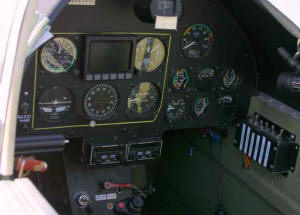| Titan Aircraft T-51 Mustang Specifications and Performance | | EMPTY WEIGHT | 850 lbs | | GROSS WEIGHT | 1450 lbs | | NEVER EXCEED SPEED | 197 mph | | CRUISE SPEED | 150 mph | | STALL SPEED | 39 mph | | RANGE | 600 miles w/reserve | | CLIMB RATE | 1200 ft/min | | TAKEOFF RUN | 300 ft | | LANDING ROLL | 300 ft | | CEILING | 16000 ft | | FUEL CAPACITY | 25 gallons | | | | | LENGTH | 23’ 6” | | HEIGHT | 9’ 2” | | WING SPAN | 24’ | | WING AREA | 118 sq ft | | CABIN WIDTH | 24” | | CABIN HEAD ROOM | 48” | | CABIN LEG ROOM | 46” | | ENGINE | Rotax 912ULS | | POWER | 100 hp | | The Rotax 914 turbocharged engine is also available | He decided he couldn't use regular aircraft engines in a 3/4 scale replica because the T 51 is only about 26 inches wide, which is too narrow for most aviation engines."While automotive engines may be very reliable in a car, they tend to have problems when you start trying to turn a prop with them." With the introduction of the Rotax 912 S and 914 he had his power plant and the design which had been in his head for over 19 years started to take form. John decided that rather than have a very hot plane, he wanted a more "friendly flyer," by using the lighter weight Rotax 912 S rather than heavy automotive conversions and a larger wing area he was able to accomplish this. The Titan T 51 is a plane that the "weekend flyer" can handle without any "pucker factor". To do this John felt he needed a relatively low stall speed in the 40 mph range, but still have a cruise speed in the 150 mph range.
The 912 S at 100 HP gave John the power and reliability he needed in a light weight package. In 1996 the T51 began to take shape in the back corner of the shop with a first mock up. With access to full scale Mustang John began to take measurements, and seeing "whether  I could get the look I wanted using straight panels," which would enable the kit to be built without a lot of compound curves. This would make the kit simpler to build and require less factory tooling. I could get the look I wanted using straight panels," which would enable the kit to be built without a lot of compound curves. This would make the kit simpler to build and require less factory tooling. Another process used to cut down on building times was to design the fuselage around a 4130 chromoly fuselage which would act as a jig for builders. This saves hundreds of hours since the builder does not have to build fixtures and jigs before starting to build. The wing construction is similar to what Titan has used for years in the Tornado series of light sport aircraft. It uses D cell construction with metal covering bonded and riveted to a metal main spar, with the major difference being that the T 51 leading edge uses a solid foam core. The center section of the wing, which houses the landing gear has been stressed to plus and minus 9 G's at 1232 lbs. which was the original sport pilot proposed weight. This strength has proven itself in a number of cases where pilots in field have dropped the plane in on the gear from 10 to 15 feet. and minus 9 G's at 1232 lbs. which was the original sport pilot proposed weight. This strength has proven itself in a number of cases where pilots in field have dropped the plane in on the gear from 10 to 15 feet. As of this writing the Titian T 51 is available only in kit form, as nothing has been done to bring it into the light sport aircraft category. The factory does the spar forward on the outer wing panels, all the control surfaces, and the center wing section is basically built. In fact if a customer is picking the kit up at the factory, the fuselage is mounted to the center section, the landing gear is extended allowing for installation onto a trailer. To complete the build the average person will spend about $600.00 on metal forming tools, cleco's, formers, air rivet gun, etc. The kit is an "assembly kit" with "no special skills required." Building times are reported in the 600 to 900 hour range. The control system is standard stick and rudder control,  with a center mounted stick and left hand throttle. The control system uses push pull tubes, except for the rudder which is cable operated. Flaps are electrically activated. with a center mounted stick and left hand throttle. The control system uses push pull tubes, except for the rudder which is cable operated. Flaps are electrically activated. The landing gear is hydraulically operated. Solo climb rates come in at around 1600 feet per minute, take off ground roll of 300 feet, with a cruise of 150 mph. Approach speed comes in at around 70 mph with touch down with flaps in the 45 mph range. The T 51 uses about 5 gallons of fuel per hour when equipped with the Rotax 912 S or 914, and carries 11 gallons in each wing tank for a total of 22 gallons. This gives a range of about 3 hours. As of this writing nearly 100 kits have been sold, with 70 in customers hands. Currently the factory is shipping a kit per week. |